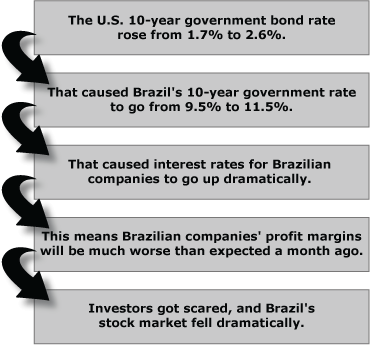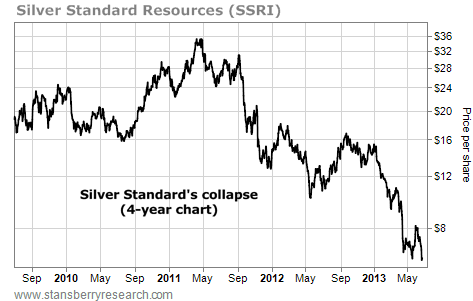| Home | About Us | Resources | Archive | Free Reports | Market Window |
Major Danger Sign from the Biggest Number in FinanceBy
Tuesday, June 25, 2013
One number is, by far, the most important number in finance...
And in the last two months, this number has soared by 60% – its greatest percentage move since 1962.
This is bad news.
When this number changes, every other number in finance changes...
When you're talking about money, the interest rate on the U.S. 10-year Treasury is the most important number on the planet. Just about everything relating to the financial markets is either based on this number or strongly affected by it.
In the last six weeks or so, the interest rate on the U.S. Treasury bond has soared from 1.7% to 2.6%. That's a huge jump in such a short time. And it's having ripple effects...
For example, mortgage rates have soared from 3.4% in early May to 4.4% today. Nothing has changed in real estate... It's just that mortgage rates are based on the 10-year government bond rate. And when it goes up, mortgage rates go up.
It's also causing Brazilian stocks to crash... The stock market in Brazil has lost 20% of its value – in just the last month. You might think that something went really wrong in Brazil for Brazilian companies to fall that much. But that's not it...
The U.S. bond yield went up... and that has crushed asset prices across the globe, including Brazilian stocks. Here's the basic idea...
 You might not have realized that what happens in a U.S. government bond affects the world. But it does... more than most people can imagine.
If this interest rate keeps going up, it could spell the end of our good times... It could mean the end of the Bernanke Asset Bubble.
I've been writing about the Bernanke Asset Bubble for years. It's the idea that Federal Reserve Chairman Ben Bernanke's zero-percent interest-rate policy will drive stock prices and home prices higher than anyone can imagine. My True Wealth subscribers have made some fantastic gains through the Bernanke Asset Bubble so far.
But we have hit a few of our "trailing stops" in recent days. If the interest rate on the 10-year Treasury keeps going up, our Global Bernanke Asset Bubble thesis will struggle.
In the short term at least, I think Treasury yields will come down. ALL the bets now are on higher interest rates for 10-year Treasurys. Usually, when EVERYONE is making the same bet, the opposite happens. The simple reason is there is nobody left to make that same bet to push it higher.
So I think the most important number in finance will start to fall – for a little while – and the boom will kick in again.
If I'm right, we'll continue to profit from the Bernanke Asset Bubble. If I'm wrong, I'm willing to follow my trailing stops and sell.
I urge you to do the same.
Good investing,
Steve
Further Reading:
Steve says one story "will help you understand exactly when to get out of this incredible stock-market and real-estate boom before it busts." Get all the details here: How the Bernanke Asset Bubble Ends.
"As soon as most individual investors see any sign of a profit, they take it. They don't let the rose bloom," Steve writes. "And instead of selling their losers, they hang on, letting them become bigger and bigger losers." One of the best ways to maximize profits... while limiting risk... is the trailing stop. Learn more about how it works here.
Market NotesA COLLAPSE IN THE SILVER MARKET Most DailyWealth readers know gold and silver stocks are struggling. But you may not realize how bad things are until you look at Silver Standard Resources (NASDAQ: SSRI)...
Silver Standard is one of the world's largest silver companies. It controls a huge in-the-ground store of silver resources. This makes it one of the "go to" silver stocks for large investors like mutual funds and hedge funds.
Like most every mining stock, Silver Standard was hammered during the 2008 credit crisis. After the crisis, the stock enjoyed a big rebound from $7 in 2009 to $35 in 2011. But since that peak in 2011, mining stocks have been locked in a horrible bear market... which today's chart shows...
As you can see, Silver Standard has fallen from its peak of around $35 per share to a recent low of $5.87, a huge, 83% fall. In other words, Silver Standard fell 50%... then 50% again... and then it fell some more. This price action from a market leader shows a sector in crisis.
 |
In The Daily Crux
Recent Articles
|


